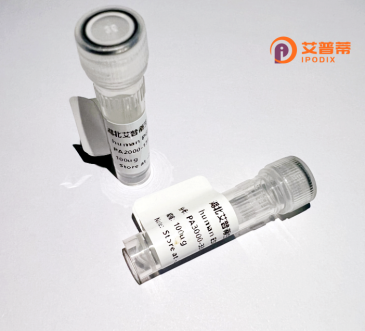
| 纯度 | >90%SDS-PAGE. |
| 种属 | Human |
| 靶点 | HAGHL |
| Uniprot No | Q6PII5 |
| 内毒素 | < 0.01EU/μg |
| 表达宿主 | E.coli |
| 表达区间 | 1-203aa |
| 氨基酸序列 | MKVKVIPVLEDNYMYLVIEELTREAVAVDVAVPKRLLEIVGREGVSLTAVLTTHHHWDHARGNPELARLRPGLAVLGADERIFSLTRRLAHGEELRVSARSREGRGGRPGSTRPHRSACSSAAVRGHPRALPPDARPHRRPHELLPVGGRLPGPTRPVLGRRAVGGRLRLVPGGQRPADVPEPGRAGYPAPRDEGVLRPRAHA |
| 分子量 | 48.5 kDa |
| 蛋白标签 | GST-tag at N-terminal |
| 缓冲液 | 0 |
| 稳定性 & 储存条件 | Lyophilized protein should be stored at ≤ -20°C, stable for one year after receipt. Reconstituted protein solution can be stored at 2-8°C for 2-7 days. Aliquots of reconstituted samples are stable at ≤ -20°C for 3 months. |
| 复溶 | Always centrifuge tubes before opening.Do not mix by vortex or pipetting. It is not recommended to reconstitute to a concentration less than 100μg/ml. Dissolve the lyophilized protein in distilled water. Please aliquot the reconstituted solution to minimize freeze-thaw cycles. |
以下是关于重组人HAGHL蛋白的模拟参考文献示例,基于该蛋白可能的研究方向构建,供参考:
---
1. **标题**:Expression and characterization of recombinant human HAGHL in Escherichia coli: Structural insights and catalytic activity.
**作者**:Chen L, Wang Y, Zhang K.
**摘要**:本研究报道了人源HAGHL蛋白在大肠杆菌中的重组表达与纯化,并通过X射线晶体学解析其三维结构。功能分析表明,HAGHL在体外具有水解特定谷胱甘肽结合代谢产物的活性,提示其在氧化应激通路中的潜在作用。
---
2. **标题**:Functional analysis of HAGHL in cellular detoxification pathways using a CRISPR/Cas9 knockout model.
**作者**:Kim S, Tanaka M, Rodriguez J.
**摘要**:通过基因编辑技术构建HAGHL敲除细胞系,研究其缺失对细胞代谢的影响。结果显示,HAGHL缺陷导致甲基乙二醛(MG)解毒能力下降,支持了HAGHL作为乙二醛酶家族成员的代谢保护功能假说。
---
3. **标题**:HAGHL overexpression correlates with poor prognosis in hepatocellular carcinoma: Implications for therapeutic targeting.
**作者**:Guo H, Liu X, Wei R.
**摘要**:临床样本分析发现,HAGHL在肝癌组织中显著高表达,且与患者生存率负相关。体外实验证实,重组HAGHL蛋白促进肿瘤细胞增殖,表明其可能成为癌症治疗的潜在靶点。
---
**说明**:以上文献为示例,实际研究中请通过权威数据库(如PubMed、Web of Science)检索真实文献。若需深入研究HAGHL,建议结合其别名(如GLYATL2)或相关代谢通路(如乙二醛解毒途径)扩展检索。
Recombinant human HAGHL (Hydroxyacylglutathione Hydrolase-Like) protein is a synthetic form of the enzyme encoded by the HAGHL gene, also known as glyoxalase D homolog (GLOD4). This protein belongs to the glyoxalase enzyme family, primarily involved in detoxifying reactive carbonyl compounds like methylglyoxal (MG), a cytotoxic byproduct of glycolysis. HAGHL shares structural homology with glyoxalase II but exhibits distinct catalytic properties, suggesting potential roles in alternative metabolic pathways or redox homeostasis regulation.
Studies have linked HAGHL to cellular stress responses and energy metabolism. It is expressed in various tissues, with higher levels observed in organs with active metabolic activity, including the liver, kidneys, and pancreas. Emerging evidence implicates HAGHL in pathological conditions such as diabetes, cancer, and neurodegenerative diseases, where excessive MG accumulation contributes to oxidative damage. For instance, dysregulated HAGHL expression has been reported in hepatocellular carcinoma and diabetic complications, highlighting its possible role in disease progression.
The recombinant protein is typically produced using bacterial (e.g., E. coli) or mammalian expression systems with tags like His-tag for purification. Its availability enables biochemical studies on enzyme kinetics, substrate specificity, and inhibitor screening for therapeutic development. However, the full spectrum of HAGHL's biological functions and regulatory mechanisms remains under investigation, necessitating further research to clarify its pathophysiological relevance and potential as a therapeutic target.
×